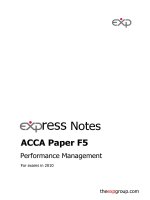ACCA paper f5 performance management
Bạn đang xem bản rút gọn của tài liệu. Xem và tải ngay bản đầy đủ của tài liệu tại đây (235.51 KB, 10 trang )
ACCA
Paper F5
Performance management
Pocket notes
Performance management
British library
cataloguing-in-publication
data
A catalogue record for this book is available
from the British Library.
Published by:
Kaplan Publishing UK
Unit 2 The Business Centre
Molly Millars Lane
Wokingham
Berkshire
RG41 2QZ
ISBN 978-1-78415-241-3
© Kaplan Financial Limited, 2015
Printed and bound in Great Britain.
ii
The text in this material and any others
made available by any Kaplan Group
company does not amount to advice on a
particular matter and should not be taken
as such. No reliance should be placed on
the content as the basis for any investment
or other decision or in connection with any
advice given to third parties. Please consult
your appropriate professional adviser as
necessary. Kaplan Publishing Limited and
all other Kaplan group companies expressly
disclaim all liability to any person in respect
of any losses or other claims, whether
direct, indirect, incidental, consequential or
otherwise arising in relation to the use of
such materials.
All rights reserved. No part of this publication
may be reproduced, stored in a retrieval
system, or transmitted, in any form or
by any means, electronic, mechanical,
photocopying, recording or otherwise,
without the prior written permission of
Kaplan Publishing.
kaplan publishing
paper F5
Contents
Chapter 1: A revision of F2 topics ...................................................................................................1
Chapter 2: Advanced methods......................................................................................................... 5
Chapter 3: Cost volume profit analysis........................................................................................... 17
Chapter 4: Planning with limiting factors........................................................................................ 23
Chapter 5: Pricing...........................................................................................................................31
Chapter 6: Relevant costing...........................................................................................................39
Chapter 7: Risk and uncertainty ...................................................................................................43
Chapter 8: Budgeting ...................................................................................................................49
Chapter 9: Quantitative analysis ...................................................................................................65
Chapter 10: Advanced variances..................................................................................................... 69
Chapter 11: Performance measurement and control ...................................................................... 79
Chapter 12: Transfer pricing and divisional performance measurements........................................ 85
Chapter 13: Performance measurements in not-for-profit organisations......................................... 91
Chapter 14: Performance management and information sysytems................................................. 93
Index
kaplan publishing
......................................................................................................................................I.1
iii
Performance management
The exam
The examiner’s key concerns
Section A comprises 20 multiple choice
questions of 2 marks each.
•
Students need to be able to interpret
any numbers they calculate and see the
limitations of their financial analysis.
•
In particular financial performance
indicators may give a limited perspective
and NFPIs are often needed to see the
full picture.
•
Questions will be practical and realistic,
so will not dwell on unnecessary
academic complications.
•
Many questions will be designed so
discussion aspects can be attempted
even if students have struggled with
calculation aspects.
Section B comprises 3 × 10 mark questions
and 2 × 15 mark questions.
Total time allowed: 3 hours plus 15 minutes
reading and planning time.
There will be an even mixture of written
requirements and computational
requirements. The two 15 mark questions
will come from decision making techniques,
budgeting and control or performance
measurement and control areas of the
syllabus.
iv
kaplan publishing
paper F5
Exam technique
Time management
A common problem on this type of paper is
that students spend too long on calculations
and don’t have enough time to do themselves
justice on the discussion aspects. Allocate
your time and stick to it!
Question requirements and answer content
Ensure you read each question requirement
at least twice before you start, and again
when you have finished answering it. Have
you actually addressed the requirement? If
the question says for example, ‘discuss the
issues to be considered when switching
to ZBB’ – don’t then simply describe ZBB;
discuss the issues when switching!
Quality and accuracy are of the utmost
importance to us so if you spot an error in
any of our products, please send an email
to with full
details, or follow the link to the feedback
form in MyKaplan.
Our Quality Co-ordinator will work with our
technical team to verify the error and take
action to ensure it is corrected in future
editions.
Reading time
The 15 minutes reading time should be
spent on reading and planning to develop a
structure to your answers.
kaplan publishing
v
Performance management
vi
kaplan publishing
1
chapter
A revision of F2 topics
1
A revision of F2 topics
A revision of
F2 pockets
Traditional costing
methods
Standard costing
Standard costs
Flexible
budgeting
Definition
Controllability
Uses
Performance
Management
Absorption costing
Marginal costing
Types of standards
2
kaplan publishing
Chapter 1
Exam focus
Basic standards were tested in Section A of the December 2014 exam (Question 3)
Cost definitions examples
Ideal
standard
•
Ideal operating conditions
•
Highlights cost of inefficiencies
Attainable
standard
•
Efficient operating conditions
•
Includes allowance for wastage
Current
standard
•
Current operating conditions
•
No incentive to improve efficiency
Basic
standard
•
Set for the long term
•
Highlights changes in costs
kaplan publishing
Uses of standard
costing
•
performance
management
•
inventory valuation
•
setting selling
prices
•
budgeting
•
management by
exception
3
A revision of F2 topics
4
kaplan publishing









